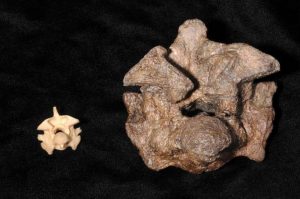Podcast: Play in new window | Download (Duration: 7:42 — 8.5MB)
Thanks to Max for suggesting Titanoboa!
Further reading:
This Nearly 50-Foot Snake Was One of the Largest to Slither on Earth
Meet Vasuki indicus, the ‘crocodile’ that was a 50ft snake
Titanoboa had really big bones compared to its modern relatives:

Vasuki had big bones too:

Show transcript:
Welcome to Strange Animals Podcast. I’m your host, Kate Shaw.
Almost exactly two years ago now, Max emailed to suggest we talk about titanoboa. The problem was that we had covered titanoboa in episode 197, and even though there’s always something new to learn about an animal, in this case since titanoboa is extinct there wasn’t much more I could share until new studies were published about it. But as the years passed I felt worse and worse that Max was waiting so long. A lot of listeners have to wait a long time for their suggested episode, and I always feel bad. But still there were no new studies about titanoboa!
Why am I telling you all this? Because we’re finally going to talk about titanoboa today, even though by now Max is probably old and gray with great-grandkids. But we’re only going to talk about titanoboa to compare it to another extinct snake. That’s right. Paleontologists have discovered fossils of a snake that was even longer than titanoboa!
Let’s start with Titanoboa, because it’s now been a really long time since episode 197 and all I remember about it is that it’s extinct and was way bigger than any snake alive today. Its discovery is such a good story that I’m going to include it too.
In 1994, a geologist named Henry Garcia found an unusual-looking fossil in Colombia in South America, in an area that had been strip-mined for coal. Fifty-eight million years ago the region was a hot, swampy, tropical forest along the edge of a shallow sea.
Garcia thought he’d found a piece of fossilized tree. The coal company in charge of the mine displayed it in their office along with other fossils. There it sat until 2003, when palaeontologists arranged an expedition to the mine to look for fossil plants. A researcher named Scott Wing was invited to join the team, and while he was there he poked around among the fossils displayed by the mining company. The second he saw the so-called petrified branch he knew it wasn’t a plant. He sent photos to a colleague who said it looked like the jawbone of a land animal, probably something new to science.
In 2007, the fossil was sent for study, labeled as a crocodile bone. But the palaeontologists who examined the fossil in person immediately realized it wasn’t from a crocodile. It was a snake vertebra—but so enormous that they couldn’t believe their eyes. They immediately arranged an expedition to look for more of them, and they found them!
Palaeontologists have found fossilized remains from around 30 individual snakes, including young ones. The adult size is estimated to be 42 feet, or 13 meters. The largest living snakes are anacondas and reticulated pythons, with no verified measurements longer than about 23 feet long, or 7 meters. Titanoboa was probably twice that length.
Because titanoboa was so bulky and heavy, it would be more comfortable in the water where it could stay cool and have its weight supported. It lived in an area where the land was swampy with lots of huge rivers. Those rivers were full of gigantic fish and other animals, including a type of lungfish that grew nearly ten feet long, or 3 meters. Studies of titanoboa’s skull and teeth indicate that it probably mostly ate fish.
So if titanoboa was so huge that until literally a few days ago as this episode goes live, we thought it was the biggest snake that had ever existed, how big was this newly discovered snake? It’s called Vasuki indicus and while it wasn’t that much bigger than titanoboa, estimates so far suggest it could grow almost 50 feet long, or over 15 meters. It’s named after a giant serpent king called Vasuki from Hindu folklore, who symbolizes strength and prosperity.
Vasuki indicus was discovered in a mine in India in 2005. The original discovery consisted of 27 vertebrae, including some that were still articulated. That means they remained in place after the rest of the body decayed and were preserved that way, which helps palaeontologists better estimate the snake’s true size.
Like titanoboa, the fossils were misidentified at first. They were labeled as a known giant crocodile and set aside in the discoverer’s lab for decades. In 2022, paleontologist Debajit Datta joined the lab, and one of the things he wanted to study were these giant crocodile fossils. He started preparing them for study by removing the rock matrix from around them, and almost immediately realized they belonged to a snake, not a crocodile.
The fossils have been dated to about 47 million years ago in what is now India, in Asia. Titanoboa lived about 58 million years ago in what is now Colombia, in South America. The two snakes are related, although not closely, and this helps scientists determine how snakes spread across the world as the continents moved into their current positions.
Both snakes lived in what were then very similar habitats, a tropical, swampy area near the coast. The researchers think Vasuki spent most of its time on land, unlike titanoboa. It wasn’t as bulky as titanoboa and could probably maneuver on land a lot more easily.
Until titanoboa was described in 2009, a snake called Gigantophis was thought to be the largest snake that ever lived. It lived around 40 million years ago in what is now the northern Sahara desert and could grow over 35 feet long, or almost 11 meters. It turns out that Vasuki was closely related to gigantophis.
As it stands now, until more fossils are found and more studies are conducted and published, Vasuki is estimated to be slightly longer than titanoboa at maximum, making it the longest snake known, but titanoboa is still estimated to be the heaviest snake known. So they both win the largest snake award, but the real winner is us.
You can find Strange Animals Podcast at strangeanimalspodcast.blubrry.net. That’s blueberry without any E’s. If you have questions, comments, or suggestions for future episodes, email us at strangeanimalspodcast@gmail.com. We also have a Patreon at patreon.com/strangeanimalspodcast if you’d like to support us for as little as one dollar a month and get monthly bonus episodes.
Thanks for listening!